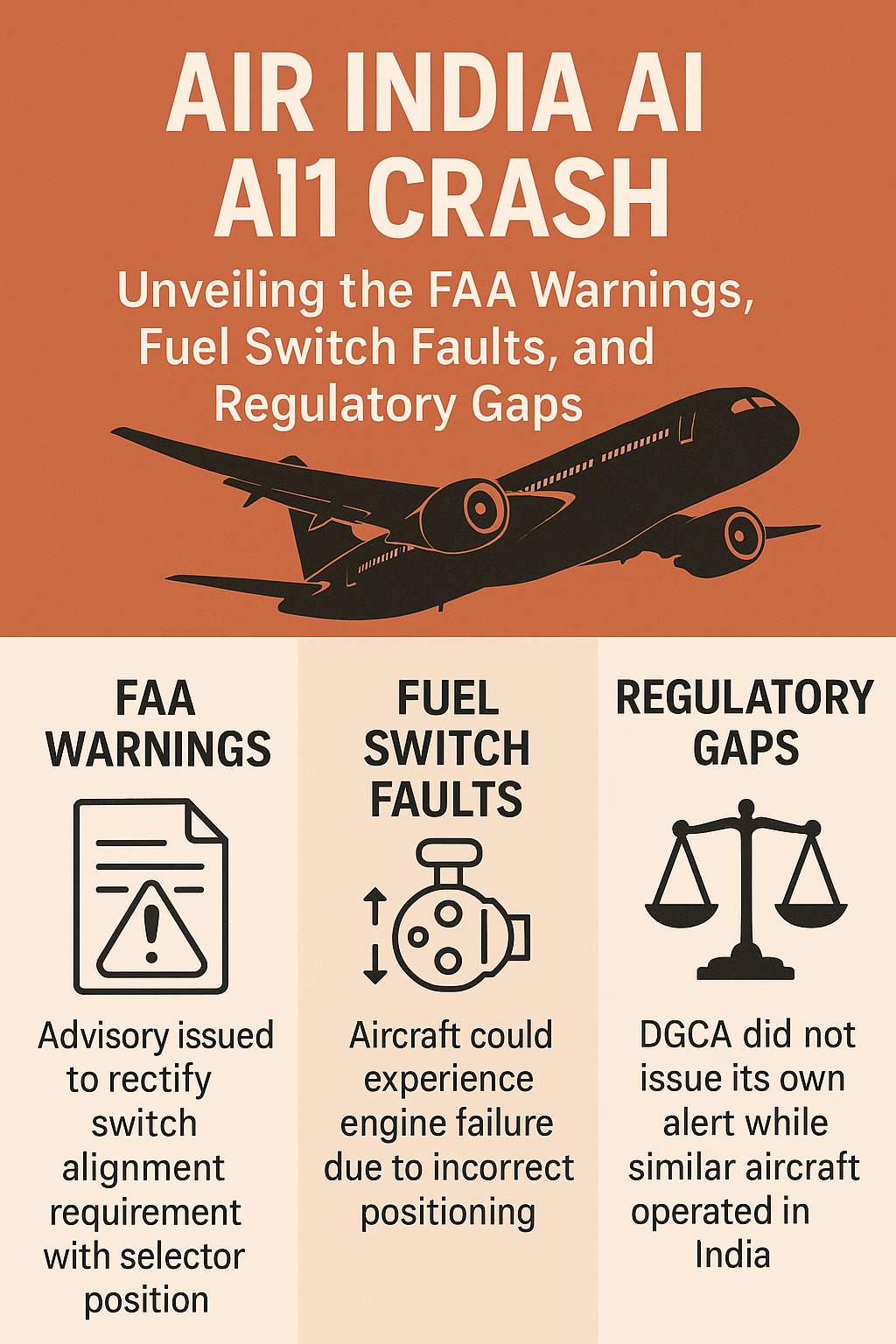In a tragic incident that stunned the nation and aviation community alike, Air India Flight AI-171 crashed just moments after takeoff from Ahmedabad on June 12, 2025, resulting in the deaths of 260 people. A month later, the Aircraft Accident Investigation Bureau (AAIB) has released its preliminary findings, shedding new light on the cause of the disaster. At the heart of the crash lies a critical in-flight action—both engine fuel switches were set to “CUTOFF” shortly after takeoff, starving the engines and triggering a cascade of failures that led to one of India’s deadliest aviation tragedies.
Fuel Switches Accidentally or Deliberately Moved
According to the 15-page report by AAIB, the Boeing 787 Dreamliner took off normally at 5:48 a.m. local time. Just seconds after liftoff, both engines lost power. Investigators have confirmed that the fuel control switches—which regulate fuel flow to the engines—were manually moved from “RUN” to “CUTOFF.” This action effectively shut down both engines while the aircraft was still ascending, leaving it with no thrust during a critical phase of flight.
The cockpit voice recorder revealed a shocking exchange: one pilot asked, “Why did you cut-off?” and the other replied, “I didn’t.” A “Mayday” call was issued moments later, but by then, the aircraft had lost altitude rapidly and slammed into a medical college staff hostel near the airport perimeter.
Despite the pilots' attempt to restart the engines, only the left engine recovered briefly. However, the right engine failed to generate enough thrust to lift the aircraft above surrounding structures. The crash occurred just 32 seconds after takeoff.
No Bird Strike, No Sabotage — But Design Concerns Persist
Initial speculation included bird strikes, engine failure, or external interference. However, the AAIB report confirms that no such factors were involved. The engines were mechanically intact and showed no signs of bird ingestion or sabotage. Instead, the focus has shifted to how the fuel switches were toggled mid-air—a highly unusual and dangerous occurrence.
Interestingly, these switches are built with safety guards specifically designed to prevent accidental movement. Boeing had acknowledged a potential vulnerability back in 2018 and issued an FAA bulletin advising enhanced precautions. However, it was not classified as mandatory, and Air India did not implement any changes or inspections related to that advisory.
Now, questions are being raised about cockpit ergonomics, crew training, and whether a software or hardware miscue could have triggered the command unintentionally. AAIB has stated that the investigation is ongoing, and no conclusive evidence has yet established whether the switch movements were due to human error or a deeper system fault.
The Aftermath: Ground Casualties and a Lone Survivor
The crash killed all but one of the 241 people on board. The lone survivor, 28-year-old Vishwashkumar Ramesh, was seated near the rear of the aircraft and escaped with severe injuries. Additionally, 19 residents of the medical college staff quarters were killed instantly as the aircraft hit the building’s top floors.
Among the deceased were foreign nationals, students, and public figures—including former Gujarat Chief Minister Vijay Rupani. His remains were identified days later via DNA testing. Memorial services have been held across the country, with the government announcing compensation and public mourning.
Boeing and DGCA Under Pressure
With Boeing already facing global scrutiny over safety lapses, this incident has intensified calls for systemic reform. The Indian Directorate General of Civil Aviation (DGCA) has initiated a parallel review of all Boeing 787 operations in India and is considering stricter protocols for cockpit switch designs and pilot response drills.
Boeing, in a statement, has offered full cooperation and reiterated its confidence in the aircraft’s design. However, industry analysts warn that previous design advisories not being acted upon may become a central point in legal and regulatory fallout. Aviation regulators worldwide may now revisit the 2018 FAA bulletin and consider making inspections mandatory.
What Lies Ahead: Final Report and Systemic Changes
The final report from AAIB is expected within the next few months. It will delve deeper into flight data, maintenance records, human factors, crew fatigue, cockpit design, and software logic governing engine controls.
There is widespread expectation that the report will include safety recommendations affecting Boeing’s global fleet, particularly regarding redundant safety checks around engine fuel control. Experts also anticipate mandatory simulator training modules to handle rare but catastrophic fuel loss scenarios.
In the meantime, grieving families and a shocked aviation industry await answers to a chilling question: How could two trained pilots, flying one of the world’s most advanced aircraft, allow both engines to shut down within seconds of liftoff?









